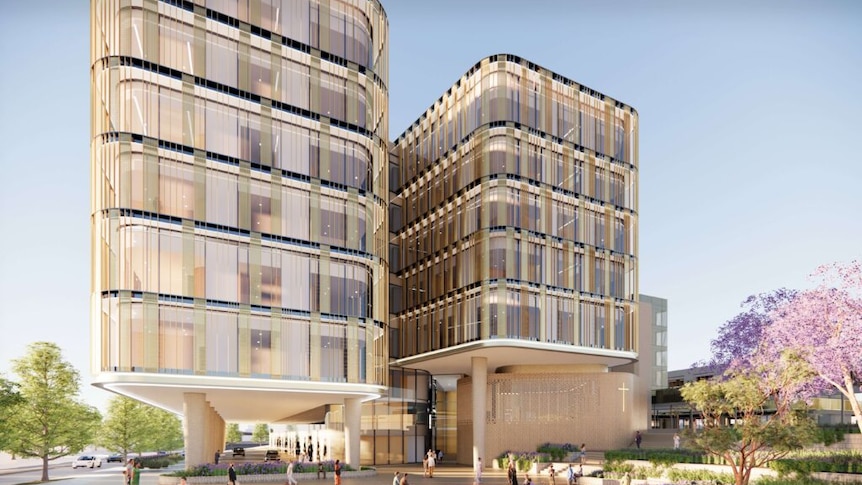Health industry experts say WA’s rising number of private emergency departments is unlikely to erode investment in public hospitals, but patients should understand the limitations and costs of private EDs.
Key points:
- For almost 20 years, the only private emergency department in WA was the St John of God facility in Murdoch
- Perth is expected to have three private emergency rooms by late 2025
- Patients are urged to be aware of potential costs when visiting private emergency departments
By the end of 2025, the number of private emergency departments — which charge up to $295 to see a doctor — is expected to have tripled in WA.
“It is a little bit curious because emergency departments are not profitable things for private hospitals,” St John of God Health Care Group chief executive Shane Kelly said.
“They’re generally run at a loss.”
For almost 20 years, the only private emergency department in WA was the St John of God facility in Murdoch.
In November, Hollywood Hospital opened a $67 million emergency department.
In May, the hospital said it had seen 5,000 patients in its first six months. It charges a $200 consultation fee.
St John of God Health Care Group has also announced plans to build the state’s third private emergency department at its Subiaco hospital by the end of 2025.
Rise reflects demand, chief says
Dr Kelly said the rising investment in private emergency departments in WA reflected high demand for emergency care overall.
“Obviously, our public emergency departments are pretty busy — very busy, in fact — and, I think, they’re looking for another option,” he said.
The motivation for private hospitals, Dr Kelly said, was to fill empty beds by bringing more patients to the hospital door.
St John of God hospitals waives the emergency consultation fee of $295 if patients are admitted into the hospital, he said.
Since it opened in 1994, St John of God’s Murdoch-based emergency department has seen about 20,000 patients annually.
Fees raised to ‘moderate’ demand
But last year, as the community spread of COVID-19 ballooned, the facility found itself under pressure as patient numbers reached a record high of 25,000.
Pandemic-related staff shortages were also affecting the private ED’s capacity, Dr Kelly said.
Demand for the facility grew so high that the facility raised its fees by $100 to $295.
“We were trying to moderate the demand a little bit,” Dr Kelly said.
He said patient numbers had dropped back to normal in 2022, which he said was likely linked to the fee hike and the launch of the Hollywood facility in November.
Dr Kelly said he did not believe the growing number of private hospitals would reduce investment in public emergency departments, already under enormous stress, because he said the number of private patients was “modest” overall.
“For example, we see about 80,000 a year in our St John of God public emergency department at Midland,” Dr Kelly said.
But, he said, they only saw up to 25,000 patients at the emergency hospital.
“So that puts it in perspective,” Dr Kelly said.
More choice for consumers
WA Health Consumers’ Council deputy director Clare Mullen said providing more choices would be positive for health care overall.
“If somebody has the choice, and they are prepared and informed about the costs, and that’s something that they want to do … by diverting somebody from a public emergency service then they’ll be creating space for someone else who is also needing that care ,” Ms. Mullen said.
She did not believe the rising number of private emergency departments would lead to any change in the quality of public emergency care.
But she said it was important that private health services were transparent about the costs.
“So, if there’s any potential limitations to the care or, obviously, out-of-pocket costs, that’s a really important thing so that people can make an informed choice,” Ms Mullen said.
David Mountain, an associate professor of emergency medicine at the University of WA, said private emergency departments did not necessarily have the same specialist facilities as public hospitals.
“They can’t provide all the services,” Dr Mountain said.
“They don’t have access to everything that’s required to manage patients who are coming through emergency departments.
“There can be problems as well, for the patients coming through expecting they’ll get everything, and in fact, it’s not all available.”
If a private emergency department does not have the specific service needed by the patient, they are transferred to public hospitals at their own cost.
In some cases, those costs, unlike the ED fee, may be covered by their insurers.
Dr Mountain does not believe the rise of private emergency departments will have any significant impact on public health care long-term.
He said any reduction in the number of patients visiting public hospitals would be small.
“A lot of the stuff that’s too complex will end up coming back to the public system anyway,” Dr Mountain said.
“Often, all it does is find an unmet need or unmet demand that’s not being catered for by the public system.”
Dr Mountain said Queensland was an example, where the number of public emergency departments remained the same despite an increase in private departments.
Dr Kelly said the new Subiaco facility was still in the planning phase, and there was a small chance the facility could become an acute admission center instead of a full-scale emergency department.
.
